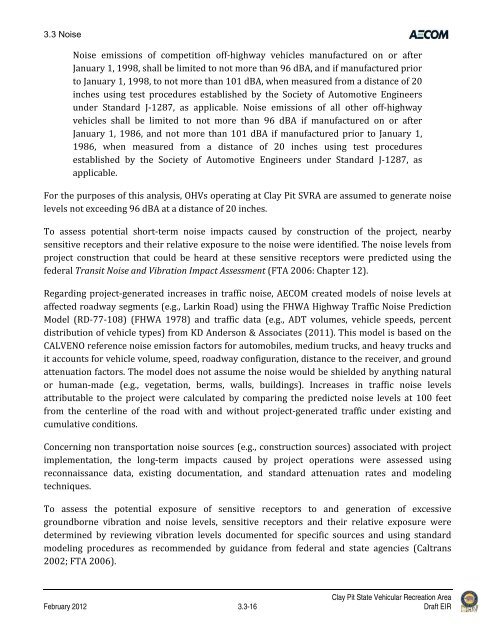Draft Environmental Impact Report - California Off Highway Vehicle ...
Draft Environmental Impact Report - California Off Highway Vehicle ...
Draft Environmental Impact Report - California Off Highway Vehicle ...
You also want an ePaper? Increase the reach of your titles
YUMPU automatically turns print PDFs into web optimized ePapers that Google loves.
3.3 Noise<br />
Noise emissions of competition off‐highway vehicles manufactured on or after<br />
January 1, 1998, shall be limited to not more than 96 dBA, and if manufactured prior<br />
to January 1, 1998, to not more than 101 dBA, when measured from a distance of 20<br />
inches using test procedures established by the Society of Automotive Engineers<br />
under Standard J‐1287, as applicable. Noise emissions of all other off‐highway<br />
vehicles shall be limited to not more than 96 dBA if manufactured on or after<br />
January 1, 1986, and not more than 101 dBA if manufactured prior to January 1,<br />
1986, when measured from a distance of 20 inches using test procedures<br />
established by the Society of Automotive Engineers under Standard J‐1287, as<br />
applicable.<br />
For the purposes of this analysis, OHVs operating at Clay Pit SVRA are assumed to generate noise<br />
levels not exceeding 96 dBA at a distance of 20 inches.<br />
To assess potential short‐term noise impacts caused by construction of the project, nearby<br />
sensitive receptors and their relative exposure to the noise were identified. The noise levels from<br />
project construction that could be heard at these sensitive receptors were predicted using the<br />
federal Transit Noise and Vibration <strong>Impact</strong> Assessment (FTA 2006: Chapter 12).<br />
Regarding project‐generated increases in traffic noise, AECOM created models of noise levels at<br />
affected roadway segments (e.g., Larkin Road) using the FHWA <strong>Highway</strong> Traffic Noise Prediction<br />
Model (RD‐77‐108) (FHWA 1978) and traffic data (e.g., ADT volumes, vehicle speeds, percent<br />
distribution of vehicle types) from KD Anderson & Associates (2011). This model is based on the<br />
CALVENO reference noise emission factors for automobiles, medium trucks, and heavy trucks and<br />
it accounts for vehicle volume, speed, roadway configuration, distance to the receiver, and ground<br />
attenuation factors. The model does not assume the noise would be shielded by anything natural<br />
or human‐made (e.g., vegetation, berms, walls, buildings). Increases in traffic noise levels<br />
attributable to the project were calculated by comparing the predicted noise levels at 100 feet<br />
from the centerline of the road with and without project‐generated traffic under existing and<br />
cumulative conditions.<br />
Concerning non transportation noise sources (e.g., construction sources) associated with project<br />
implementation, the long‐term impacts caused by project operations were assessed using<br />
reconnaissance data, existing documentation, and standard attenuation rates and modeling<br />
techniques.<br />
To assess the potential exposure of sensitive receptors to and generation of excessive<br />
groundborne vibration and noise levels, sensitive receptors and their relative exposure were<br />
determined by reviewing vibration levels documented for specific sources and using standard<br />
modeling procedures as recommended by guidance from federal and state agencies (Caltrans<br />
2002; FTA 2006).<br />
Clay Pit State Vehicular Recreation Area<br />
February 2012 3.3-16 <strong>Draft</strong> EIR








